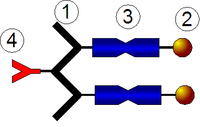
Photo from wikipedia
Abstract Effective specific recognition of bovine serum albumin (BSA) was accomplished by the thermo-sensitive imprinted microspheres composed of N-isopropylacrylamide (NIPAM), methacrylic acid (MAA) and N,N-methylenebisacrylamide (MBA). These imprinted microspheres were… Click to show full abstract
Abstract Effective specific recognition of bovine serum albumin (BSA) was accomplished by the thermo-sensitive imprinted microspheres composed of N-isopropylacrylamide (NIPAM), methacrylic acid (MAA) and N,N-methylenebisacrylamide (MBA). These imprinted microspheres were prepared in the presence of hollow Fe3O4 microspheres as substrates via surface molecular imprinting technique (MIT) and grafting copolymerization method. In the imprinting system, hollow Fe3O4 microspheres possessed the distinctive properties of excellent water dispersibility, light weight and high specific surface area. These potential benefits not only reduced the agglomeration of imprinted microspheres, but also increased the effective imprinting area for BSA. And owing to the existence of poly-(N-isopropylacrylamide) (pNIPAM), the fabricated molecularly imprinted polymers (MIPs) were highly sensitive to ambient temperature and played a significant role in efficient recognition for BSA. When treated at 32 °C, the optimal adsorption capacity (Q) and imprinting factor (IF) for BSA were obtained, 430.67 mg/g and 2.01, respectively. Combining hollow Fe3O4 microspheres with thermo-sensitive polymers, the surface-imprinted materials for specific capture of target protein would show great promise for bioseparation and biosensors.
Journal Title: Applied Surface Science
Year Published: 2019
Link to full text (if available)
Share on Social Media: Sign Up to like & get
recommendations!